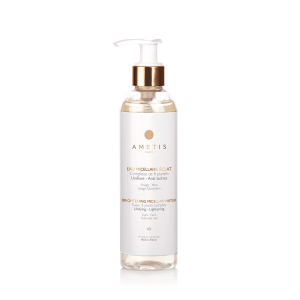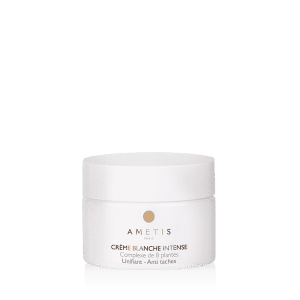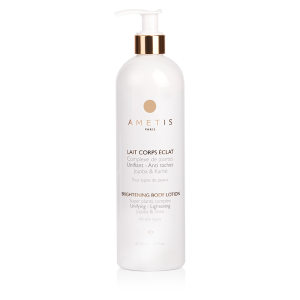Tips from Dr Mbida
- Menu
- Tips
- Summer newsletter
Tips
Dark skin is caused by skin pigmentation, for which melanocytes are responsible. In dark skin, the melanization of melanocytes differs from that of other skins. The melanosomes are large, not affected by UV exposure, and produce eumelanin – a darker form of melanin. Melanin hyperpigmentation ensures photoprotection, considerably reducing the risk of cancer by filtering UVB rays.
Dark skin is more resistant to skin aging. The hydrolipidic film, which is composed of sebum and sweat, helps to maintain skin hydration by controlling insensible water loss. The hydrolipidic film can be damaged by climatic factors in tropical areas. This results in drier skin on the body and hyperseborrhea (excess sebum) on the face. Sebum serves as a vehicle for odors between a newborn and his/her mother.
It has fungistatic and bacteriostatic properties, and helps to prevent dehydration. NMF (the Natural Moisturizing Factor) plays a role in heat regulation and helps to hold in moisture and acidic sweat.
The epidermis is compact; the stratum corneum is as thick as that of other skins, yet it has a higher number of cellular layers. This means it has a stronger barrier function thanks to the keratin in the skin, but also means that topical products applied to the skin surface are less easily absorbed.
The dermis contains melanin pigment, which is spread along the length of the hair follicle. The very compact collagen and elastin structure, combined with reticulin, provides elasticity and support.
For normal skin, the absolute minimum is to cleanse the skin surface thoroughly. This is essential to keep the complexion clear and the skin fresh and healthy. Every evening, the skin needs to be carefully cleansed to get rid of all traces of dirt. The cells of the stratum corneum are constantly flaking off. Sebum and sweat form skin waste that dulls the complexion if not eliminated. There’s also make-up and the bacteria that have built up over the course of the day.
However, it is not always easy to cleanse the skin without damaging it – and especially the skin of the face. The products used for cleansing the skin can be grouped into five categories: soaps, cleansing bars, emulsions, toners and foaming products. When it comes to caring for normal skin, there should be no need for corrective action; the skin just needs to be kept in good condition by using products that will not disrupt its balance.
Creams are most often used. In my opinion, day cream and night cream are just marketing terms. The most important thing is that creams for normal skin should keep it properly moisturized, thus ensuring protection against harsh climatic conditions and other aggressions. Creams should be applied to the face and neck every day – even on young women or women who don’t use make-up, to protect the skin.
From a cosmetic point of view (not a pathological one), oily skin has a shiny appearance. It is quite difficult to apply make-up to oily skin, as the products won’t stay put! Cosmetic products for oily skin need to slow down sebum production and not exacerbate it by repeatedly stripping the skin of oil, which can trigger reactive seborrhea. So it’s important not to use harsh products aimed at making the skin less oily. Do not use harsh soaps, such as Marseille soap, or liquid soaps for dermatological use. It’s also important not to use cologne or alcohol-based products, which damage the skin’s lipid barrier, causing irritation and an increase in sebum production.
Products containing sulfur and emulsions with a high lipid content, which are too occlusive, should also be avoided. To cleanse oily skin, use a gentle cleansing bar or a lotion with an aqueous phase. Rinse the face with tap water, if the water isn’t too hard, or use spring water instead. An astringent toner is recommended. Products for oily skin often contain camphor and metallic aluminum salts, with astringent and anti-inflammatory properties.
To care for the skin, I recommend products that aim to protect the face against environmental aggressions and that can also easily serve as a make-up base. These are emulsions with a continuous aqueous phase (O/W) containing sebum-regulating substances combined with anti-inflammatory cosmetic ingredients. The products used must be non-comedogenic, otherwise they may cause hyperkeratosis if used in high concentrations. The second criterion is the proportion of the oily phase of the emulsion, which must be between 15 and 30%. If the proportion were higher, microcysts and blackheads would reappear.
First of all, it is relatively easy to identify dry skin as it often has a rough or scaly appearance, and lacks softness and suppleness. Dry skin is characterized by reduced hydration of the stratum corneum, with a percentage hydration of less than 13%. This is aggravated by climatic factors, which increase insensible water loss. A distinction should be made between fragile skin that has simply become dry and very dry, aging skin that needs more specific skincare products. Overly hydrophilic formulas are generally not advised for dry skin, since their hygroscopicity (i.e. their ability to absorb water) would increase moisture loss from the stratum corneum.
Hard water, astringent toners, harsh soaps and products containing alcohol should also be avoided. Skincare products must meet three criteria: they must hold moisture in the stratum corneum, compensate for decreased sebum production, which can occur in addition to a loss of moisture, and, finally, protect skin against climatic stresses. Products that have an occlusive effect (i.e. moisture-trapping) to slow down dehydration, as well as moistening or humectant agents, should be used for dry skin.
There are certainly examples of this happening. For example, using an African body-washing net to exfoliate can be very rough on the skin. Another example is moisturizing dry skin by using the same oily products on the face and body. When used on seborrheic facial skin, these products can trigger the appearance of acne lesions.
Unfortunately, there are some black women who misuse self-administered topical skin-lightening products. Often found at African markets, these products may contain class 1 corticosteroids, such as clobetasol, or hydroquinone, or sometimes a mixture of the two. Then there are cosmetic creams that contain more gentle active ingredients, such as alpha hydroxy acids, Vitamin C and various botanical extracts.
There are also creams that contain bleach or other, very harsh, caustic agents. The consequences of these products vary and depend on the product used. When corticosteroids are self-administered, this can result in skin atrophy, with wide stretch marks from the tops of the limbs, and also rosacea, which is unusual in dark skin. There may be acneiform eruptions and endocrine effects, with diabetes, high blood pressure and dependency. When people self-administer hydroquinone for several years, ochronosis can occur. When cosmetic creams are used, we see cases of allergies and skin reactions. As for non-defined mixtures of ingredients, all the aforementioned risks can apply – and possibly even others.
We can start by saying what shouldn’t be used. Don’t use soaps – especially acidic soaps, which can have a drying effect and often cause itching. Don’t use products that contain alcohol, including alcohol-based antiseptics. Avoid acidic Vitamin A, certain fruit acids (which could lead to unsightly pigmentation marks), rubbing, and lightening products that are sold in unregulated outlets. It’s also important to be very careful with regard to photosensitizing products, such as anxiolytics and antibiotics, as well as topically applied creams and certain fragrances.
Other products can be recommended however, such as syndet bars, creams and cleansing lotions. These are preferable to products that require water – which is often hard. Opt for purifying and/or astringent toners that are fragrance- and alcohol-free. Use gentle exfoliators that are not harsh on the skin, and don’t use them too often. When using photosensitizing products, apply sun protection with an appropriate SPF – even on dark skin.
In conclusion, having taken a critical look at a number of products sold in Africa, I would recommend the Ametis range, which provides an appropriate, perfect response to the problems affecting dark skin!
Summer newsletter
Sunny days are here and nature is in full bloom, delighting us with its dazzling colors! Temperatures are getting higher and we can bask in the sunshine! Here are a few tips to look after your skin during the summer.
To keep your skin in good condition, there are a few things you need to remember.
The AMETIS range includes a choice of exfoliators tailored to the specific needs of dark and ethnic skin, such as the White Peel-off Mask and the Skin Brightening Exfoliant Mask. Whatever your skin type, a purifying, exfoliating scrub is always essential when you transition from winter to summer. During the winter months, the cold weather and lack of daylight lead to a build-up of toxins – and we know that the body’s toxins are excreted through the skin. The Skin Brightening Exfoliant Mask works to exfoliate and purify the skin, ridding it of dead cells in the stratum corneum and thus promoting a more radiant complexion.
Extensive exposure to sunshine can lead to problems ranging from sunburn to skin cancer, so sun protection is essential! Dark skin’s natural defenses against the sun may be stronger than those of fair skin, but it still needs protection to prevent hyperpigmentation spots.
When the stratum corneum is well moisturized, the skin looks good and feels smooth, supple, elastic and velvety. Keep your body well hydrated by drinking lots of water, and keep your skin well hydrated by applying moisturizer to the face and body. Make sure you always use one that suits your skin, as cosmetic formulations are tailored to different skin types. Using products not suited to your skin can have undesirable consequences. Hydration of the stratum corneum is dependent on the balance created between the diffusion of moisture in the dermal and epidermal layers.
The skin’s ability to hold in moisture is due to the presence of a mixture of components known under the term NMF (Natural Moisturizing Factor). These moisturizing agents are found in cosmetic formulations. If you look at the formulas in the AMETIS range, you’ll find products that contain them, such as the Body Lotion, the Hydra Pure Fluid Cream, the Balancing Day Creams and the Deep Moisturizing Balm Body Care.
Ridding the body of stress induces the elimination of biogenic amines, which are highly oxidative and play a role in skin and cellular aging. To lower your stress levels, take up a sport and eat a balanced diet rich in antioxidant flavonoids.
Finally, I’d like to say that staying in a good mood is an excellent way to fight wrinkles!
Made in France
Cruelty free
Dermatological expertise
Natural origin
Support of an NGO
Delivery
Delivery in Europe and Worldwide.
Secure payment
Secure payment by Credit card and Paypal.
Customer service
Ask us all your questions.


